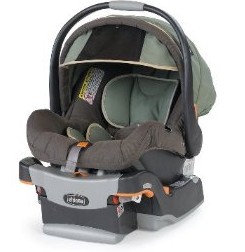 Thanks to the reviews in Baby Bargains (affiliate link), extensive research, and a visit to some baby stores to test them out, we’ve narrowed down our choices for infant car seats to two options.
Thanks to the reviews in Baby Bargains (affiliate link), extensive research, and a visit to some baby stores to test them out, we’ve narrowed down our choices for infant car seats to two options.
We opted to choose an infant car seat instead of a rear-facing convertible that will last longer because we’d like to have the option to use the seat as an infant carrier. With the history of giant babies in our families, I doubt we’ll want to lug him around in an awkward 10-pound car seat for very long. But I think in the very beginning it will be handy to be able to lift him out of the car and carry him without uncovering him, especially since he’ll be born at the beginning of a very cold Midwestern winter.
A few weeks ago, we were pretty sure we were set on the Graco SnugRide 35 (affiliate link). It has an A-rating for safety and usability in Baby Bargains, and it’s a top seller. I like that it’s safe to use until the baby is 35 pounds or 32 inches, which means we should be able to get through most of his first year without replacing his car seat. We probably won’t be using it as a carrier for that long, but the longer I can use this seat, the better. I also like that it’s compatible with a wide range of stroller frames and other baby gear. We’re opting to skip the travel system and use a sling exclusively for at least the first few months, but I like having the option to get the stroller later if for some reason baby wearing just isn’t working for us.
We made this decision without ever seeing the car seats in person, though. So Saturday, we took a short trip to the nearest baby store (about 45 minutes away), and checked out our options.
We liked the SnugRide 35. But. For comparison, we also looked at another high-rated infant seat/carrier: the Chicco Keyfit 30 (affiliate link). The Keyfit has a weight limit of 30 pounds and a height guideline of 30 inches. It won’t last quite as long as the SnugRide, but I think the difference is negligible.
The biggest difference between the two is size of the actual seat. The Keyfit felt much lighter. I found out when we got home that the difference is only about a pound, but it felt much lighter than that. I’m guessing when you add a 10-15 pound baby to the seat, every pound counts.
More importantly, it was about 2-3 inches more compact than the SnugRide 35. It’s also safe to leave the handle up when the Keyfit is installed in the in-car base. The SnugRide 35 handle must be down in the locked position, which adds even more length to the seat.
We weren’t able to take the seats out to our car to test the fit. This is our main concern: we share a single vehicle, and it’s a Hyundai Accent. It’s a four-door, but it’s still a pretty small, sub-compact car. We’re concerned that the extra bulk and the handle on the SnugRide 35 might make for a tight squeeze in our backseat.
Tony much preferred the Keyfit. He said it felt lighter and easier to carry, and since he’ll likely be saddled with lugging the infant carrier more often than me, I’m inclined to let him choose. But I’m bothered by the compatibility issues with the Keyfit. We’d rather avoid getting a stroller frame for the infant carrier, but if the need arises, I like that the SnugRide offers so many options. Our options for the Keyfit are pretty limited.
Do any of you have any experience using the SnugRide 35 or the Chicco Keyfit 30 in a sub-compact car (particularly a Hyundai Accent)? Or do you have any feedback on either seat in general? I’m hoping your feedback will push us over the edge for either seat, because right now we’re torn.